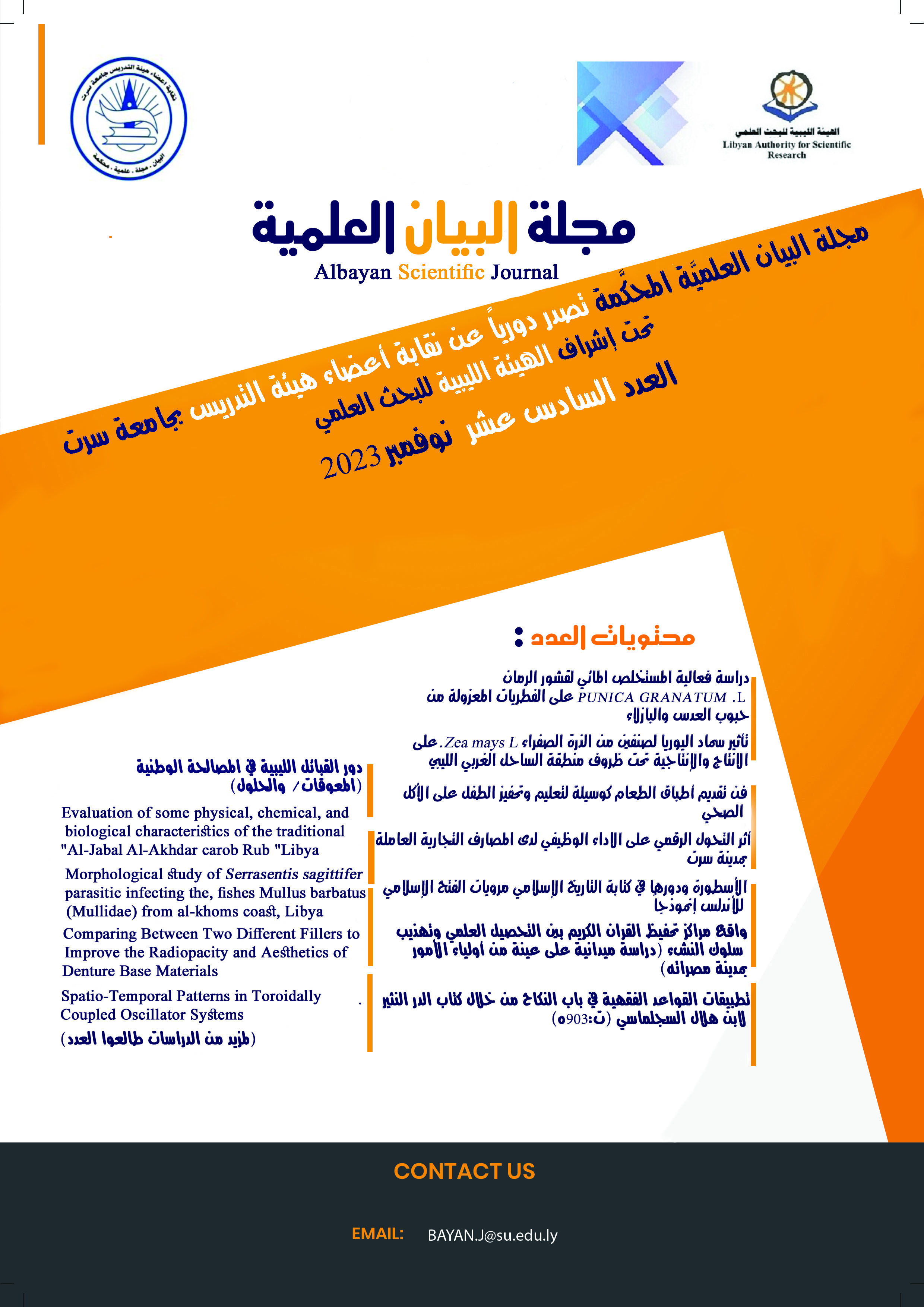Evaluation of some physical, chemical, and biological characteristics of the traditional Al-Jabal Al-Akhdar carob Rub "Libya"
DOI:
https://doi.org/10.37375/bsj.vi16.1940الكلمات المفتاحية:
Carob، , Pekmez,، Chemical and functional properties,، , Concentrated fruit juices.الملخص
The aim of this research was to study of some physical, chemical, biological and functional properties of carob Rub produced by traditional methods in Al Jabal Al Akhdar region, where seven samples of carob rub were purchased from the local market in a random manner. The results were the total solids, dissolved solids, moisture, pH and color are (59.76±6.46%, 57.94±6.73%, 40.23±6.46%, 5.23±0.26, L*21.14±0.18 a*-26.00±0.16 b* 0.53±0.02) respectively. While the average percentage of acidity, total sugars, reducing sugars, sucrose, ash, protein and hydroxymethylfurfural compound were 0.57 ± 0.16%, 41.99 ± 7.50%, 15.42 ± 1.11%, 26.57 ± 6.39%, 1.47 ± 0.50%, 23.15 ± 0.07 mg/kg) respectively. Regarding the biological properties, the mean of total phenols, flavonoids, tannins, and antioxidant activity were DPPH, ABTS (6.082 ± 0.06mEqGA/100g , 2.339 ± 0.05mEq/100 g Catechins, 3.125 ± 0.91% , 35.69 ± 0.14 , 519.38 ± 4.18) respectively, and the studied functional property, which is the ability to emulsify, was ( 10.3% ±0.15).
المراجع
References:
Abd Allah,H., Lahmer , R.,& Dogman,M. (2020). Chemical and Microbial Properties and Energy Content of Rub Al-Tamr Made by Traditional and Modern Methods. The Scientific Journal of King Faisal University. Basic and Applied Sciences, Volume (21), Issue (2).
Akbulut, M., &Özcan, M. M. (2008). Some physical, chemical, and rheological properties of sweet sorghum (Sorghum Bicolor (L) Moench) Pekmez (Molasses). International Journal of Food Properties, 11(1), 79-91.
Akkaya, Z., Schröder, J., Tavman, S., Kumcuoglu, S., Schuchmann, H. P., &Gaukel, V. (2012). Effects of spray drying on physical properties, total phenolic content and antioxidant activity of carob molasses. International journal of food engineering, 8(4).
Aliyazicioglu, R., Kolayli, S., Kara, M., Yildiz, O., Sarikaya, A. O., Cengiz, S., &Er, F. (2009). Determination of chemical, physical and biological characteristics of some pekmez (molasses) from Turkey. Asian Journal of Chemistry, 21(3), 2215-2223.
Alpaslan, M., &Hayta, M. E. H. M. E. T. (2002). Rheological and sensory properties of pekmez (grape molasses)/tahin (sesame paste) blends. Journal of Food Engineering, 54(1), 89-93.
Anonymous, (2014).FAOSTAT (Food and Agriculture Organization of The United Nations) (http://faostat.fao.org/).
Ayaz, F. A., Torun, H., Glew, R. H., Bak, Z. D., Chuang, L. T., Presley, J. M., & Andrews, R. (2009). Nutrient content of carob pod (Ceratonia siliqua L.) flour prepared commercially and domestically. J Plant Foods for Human Nutrition, 64(4), 286-292.
AOAC.(2000).Offcial Methods of Analysis of AOAC International,17 th edition.Association of Offficial Analytical Chemists ,Washington. D.C.USA.
Barracosa, P., Osorio, J., &Cravador, A. (2007). Evaluation of fruit and seed diversity and characterization of carob (Ceratoniasiliqua L.) cultivars in Algarve region. ScientiaHorticulturae, 114(4), 250-257.
Batlle, I., &Tous, J. (1990). Cultivaresautóctonos de algarrobo (Ceratoniasiliqua L.) en Cataluña. InvestigaciónAgraria, 5(2), 223-238.
Ben Ayache, S., BehijaSaafi, E., Emhemmed, F., Flamini, G., Achour, L., & Muller, C. D. (2020). Biological activities of aqueous extracts from carob plant (Ceratoniasiliqua L.) by antioxidant, analgesic and proapoptotic properties evaluation. Molecules, 25(14), 3120.
Can, H., Artik N., Certel M., (2007). Components of nutritional interest in carobpods (Ceratoniasiliqua). J. Sci. Food Agric. ,33:1319 – 1323.
Dhaouadi, K., Belkhir, M., Akinocho, I., Raboudi, F., Pamies, D., Barrajón, E., ... &Fattouch, S. (2014). Sucrose supplementation during traditional carob syrup processing affected its chemical characteristics and biological activities. LWT-Food Science and Technology, 57(1), 1-8.
Dimassi, O., Khalife, R., Akiki, R., &Rached, M. (2019). Effect of different Soaking media on the Efficiency of Carob Molasses Production. International Journal of Environment, Agriculture and Biotechnology, 4(3), 829-834.
Fidan, H., Mihaylova, D., Petkova, N., Sapoundzhieva, T., Slavov, A., &Krastev, L. (2019). Determination of chemical composition, antibacterial and antioxidant properties of products obtained from carob and honey locust. Turkish Journal of Biochemistry, 44(3), 316-322.
Fidan, H., Petkova, N., Sapoundzhieva, T., &Abanoz, E. I. (2016, September). Carbohydrate content in Bulgarian and Turkish carob pods and their products. In CBU international conference proceedings (Vol. 4, pp. 796-802).
Goulas, V., Stylos, E., Chatziathanasiadou, M. V., Mavromoustakos, T., &Tzakos, A. G. (2016). Functional components of carob fruit: Linking the chemical and biological space. International journal of molecular sciences, 17(11), 1875.
Makris, D. P., Boskou, G., &Andrikopoulos, N. K. (2007). Polyphenolic content and in vitro antioxidant characteristics of wine industry and other agri-food solid waste extracts. Journal of Food Composition and Analysis, 20(2), 125-132.
Maskan, M. (2006). Production of pomegranate (Punicagranatum L.) juice concentrate by various heating methods: colour degradation and kinetics. Journal of Food Engineering, 72(3), 218-224.
Re, R. Pellegrini, N. Proteggente, A. Pannala, A. Yang, M. and Rice-Evans, C. (1999).Antioxidant activity applying an improved ABTS radical cationdecolorization assay, Free Radical Biology and Medicine, 26: 1231-1237.
Sakcali, M.S., Ozturk, M., (2004).Eco-physiological behaviour of some Mediterranean plants as suitable candidates for reclamation of degraded areas. J. Arid Environ. 57, 1–13.
Sengül, M., Fatih Ertugay, M., Sengül, M., & Yüksel, Y. (2007). Rheological characteristics of carob pekmez. J International Journal of Food Properties, 10(1), 39-46.
Sidina, M. M., El Hansali, M., Wahid, N., Ouatmane, A., Boulli, A., &Haddioui, A. (2009). Fruit and seed diversity of domesticated carob (Ceratoniasiliqua L.) in Morocco. Scientiahorticulturae, 123(1), 110-116.
Singleton, V. L., & Rossi, J. A. (1965). Colorimetry of total phenolics with phosphomolybdic-phosphotungstic acid reagents. J American journal of Enology Viticulture, 16(3), 144-158.
Sudha, G., Vadivukkarasi, S., Shree, R. B. I., & Lakshmanan, P. (2012). Antioxidant activity of various extracts from an edible mushroom Pleurotus eous. J Food Science Biotechnology, 21(3), 661-668.
Tetik, N., Turhan, İ., Karhan, M., &Öziyci, H. R. (2010). Characterization of, and 5-hydroxymethylfurfural concentration in carob pekmez. Gida, 35(6), 417-422.
Tetik, N., Turhan, I., Oziyci, H. R., &Karhan, M. (2011). Determination of D-pinitol in carob syrup. International Journal of Food Sciences and Nutrition, 62(6), 572-576.
Toker, O. S., Dogan, M., Ersöz, N. B., & Yilmaz, M. T. (2013). Optimization of the content of 5-hydroxymethylfurfural (HMF) formed in some molasses types: HPLC-DAD analysis to determine effect of different storage time and temperature levels. Industrial Crops and Products, 50, 137-144.
Tosun, I., &Ustun, N. S. (2003). Nonenzymic browning during storage of white hard grape pekmez (Zilepekmezi). Food Chemistry, 80(4), 441-443.
Tounsi, L., Ghazala, I., & Kechaou, N. (2020). Physicochemical and phytochemical properties of Tunisian carob molasses. J Journal of Food Measurement Characterization, 14(1), 20-30.
Tounsi, L., Karra, S., Kechaou, H., & Kechaou, N. (2017). Processing, physico-chemical and functional properties of carob molasses and powders. J Journal of Food Measurement Characterization, 11(3), 1440-1448.
TÜRKBEN, C., Senem, S. U. N. A., Gökçen, İ. Z. L. İ., UYLAŞER, V., &Demir, C. (2016). Physical and Chemical Properties of Pekmez Molasses Produced with Different Grape Cultivars. Journal of Agricultural Sciences, 22(3), 339-348.
Turkmen, N., Sari, F., Poyrazoglu, E. S., &Velioglu, Y. S. (2006). Effects of prolonged heating on antioxidant activity and colour of honey. Food Chemistry, 95(4), 653-657.
Wang, B. S., Chang, L. W., Kang, Z. C., Chu, H. L., Tai, H. M., & Huang, M. H. (2011). Inhibitory effects of molasses on mutation and nitric oxide production. Food Chemistry, 126(3), 1102-1107.
Yoo, K. M., Lee, C. H., Lee, H., Moon, B., & Lee, C. Y. (2008). Relative antioxidant and cytoprotective activities of common herbs. J Food chemistry, 106(3), 929-936.














